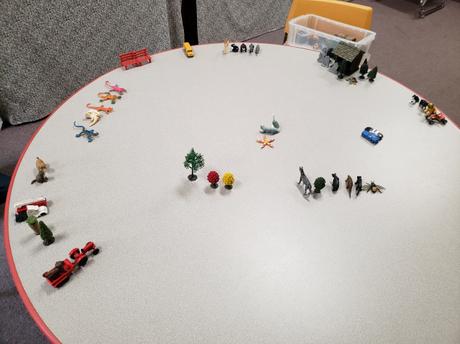 Can you see it?
Can you see it?
Take a minute to look over the picture above. Notice the details around the table. Do you see any patterns? Are the items grouped in a certain way? How is the space used? What feelings does this picture convey?
When one of my students chose to spend his 30 minutes with me carefully selecting animals, trees, vehicles, and scenery items, and even more carefully setting them up just so, I had an inkling that it might be difficult for him to clean up his work at the end of our time. So, I snapped this picture.
After painstakingly pawing through my bins of miniatures and standing them up in their rightful place, he told me what each part was, and he also had this to say: “This is my world. The world stinks and I wish it was like the one I made.”
Pretty incredible insight for a 1st grader if you ask me!
To me, this picture of his “world” is the epitome of trying to tame anxiety – of feeling like certain things are out of your control, and that when things are out of your control, it can feel pretty scary. To tame it, he created a “world” in which everything has it’s place and purpose; it’s black and white with no shades of gray.
Over my years as a school counselor, I’ve learned that anxiety can look like lots of things. It can look like the kid frozen in her seat, unmoving and non-responsive to your request. It can look like the kid bolting from the classroom. It can look like work avoidance. It can look like extreme silliness. It can look like hiding in the tiniest places imaginable. It can look like tears, or screams, or hitting. It can look like trying to be perfect. It can look like intense anger, an immature tantrum, or complete refusal. In some cases, it can look like hair pulling, carpet removal, or drywall-hole digging.
I have found that staying curious when a student is showing us behavior is our best option. It’s easy to dismiss a behavior as “just behavior,” and completely miss the anxiety underneath. But dealing with the outward behavior while not acknowledging and addressing the actual issue is a bit like pushing a car uphill instead of finding gas for the tank – you can make it (the kid or the car) do what you want for a while, but it won’t last and you will kill yourself in the process.
So, what do we do?
Here are a few strategies I have found useful when working with students exhibiting anxiety:
- CBT positive self-talk chart – I make a simple T-chart and we list negative or anxious thoughts on the left side, then come up with positive thoughts to challenge the negative on the right side. We usually practice saying the positive self-talk out loud.
- Coming up with a mantra – some phrase that’s easy to remember that the student can say whenever they feel the anxiety start to creep in.
- Body outline – the student identifies where in their body they feel their anxiety and color it in. This helps build body-mind-brain connections.
- Mindfulness – practicing deep breathing and focusing on one thing at a time is crucial in relieving anxious symptoms. I use a Hoberman sphere ball for deep breathing, and I use several videos from GoNoodle and Mind Yeti.
- Play therapy techniques like using a sand tray or using miniatures like the ones in the picture (the student ALWAYS has control over what they create).
- Coloring mandalas has proven to be a peaceful activity.
- Guided imagery and meditations can be great practice at focusing and controlling our thoughts. I have often used the Magic Carpet Exercise.
- I have used several books, such as Jonathan James and the Whatif Monster by Michelle Nelson-Schmidt, Wilma Jean the Worry Machine by Julia Cook, My Day is Ruined!: A Story for Teaching Flexible Thinking by Bryan Smith, and I just added this one to my bookshelf: Listening to My Body by Gabi Garcia.
- I have also used these videos to help start conversations with students about anxiety: Go Zen – Why Humans Experience Anxiety, Managing Worry and Anxiety for Kids (rap song), and The Science of Anxiety (brain systems).
How do you help address anxiety with your students?
Advertisements
